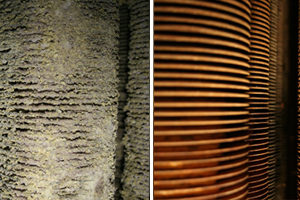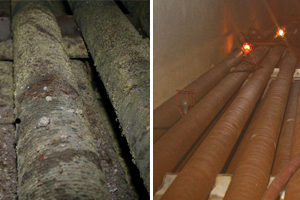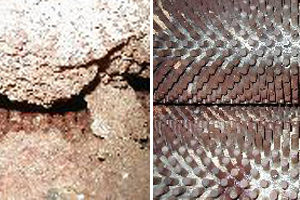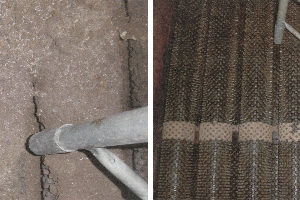Shell And Tube Exchanger Texas City Texas
Shell And Tube Exchanger Texas City Texas

Shell And Tube Exchanger Texas City Texas
An inspection is, most generally, an organized examination or formal evaluation exercise. In engineering activities inspection involves the measurements, tests, and gauges applied to certain characteristics in regard to an object or activity. The results are usually compared to specified requirements and standards for determining whether the item or activity is in line with these targets, often with a Standard Inspection Procedure in place to ensure consistent checking. Inspections are usually non-destructive. Shell and tube exchanger Texas City Texas
Inspections may be a visual inspection or involve sensing technologies such as ultrasonic testing, accomplished with a direct physical presence or remotely such as a remote visual inspection, and manually or automatically such as an automated optical inspection. Non-contact optical measurement and Photogrammetry have become common NDT methods for inspection of manufactured components and design optimization. Shell and tube exchanger Texas City Texas
A 2007 Scottish Government review of scrutiny of public services (the Crear Review, 2007 defined inspection of public services as “… periodic, targeted scrutiny of specific services, to check whether they are meeting national and local performance standards, legislative and professional requirements, and the needs of service users.” Shell and tube exchanger Texas City Texas
A surprise inspection tends to have different results than an announced inspection. Leaders wanting to know how others in their organization perform can drop in without warning, to see directly what happens. If an inspection is made known in advance, it can give people a chance to cover up or to fix mistakes. This could lead to distorted and inaccurate findings. A surprise inspection, therefore, gives inspectors a better picture of the typical state of the inspected object or process than an announced inspection. It also enhances external confidence in the inspection process. See section 4.12 of the Crear report. Shell and tube exchanger Texas City Texas
Due to the many variables involved, selecting optimal heat exchangers is challenging. Hand calculations are possible, but many iterations are typically needed. As such, heat exchangers are most often selected via computer programs, either by system designers, who are typically engineers, or by equipment vendors. Shell and tube exchanger Texas City Texas
To select an appropriate heat exchanger, the system designers (or equipment vendors) would first consider the design limitations for each heat exchanger type. Though cost is often the primary criterion, several other selection criteria are important:
High/ low-pressure limits Shell and tube exchanger Texas City Texas
Thermal performance Shell and tube exchanger Texas City Texas
Temperature ranges Shell and tube exchanger Texas City Texas
Product mix (liquid/liquid, particulates or high-solids liquid) Shell and tube exchanger Texas City Texas
Pressure drops across the exchanger Shell and tube exchanger Texas City Texas
Fluid flow capacity Shell and tube exchanger Texas City Texas
Cleanability, maintenance and repair Shell and tube exchanger Texas City Texas
Materials required for construction Shell and tube exchanger Texas City TexasAbility and ease of future expansion Shell and tube exchanger Texas City Texas
Material selection, such as copper, aluminum, carbon steel, stainless steel, nickel alloys, ceramic, polymer, and titanium. Shell and tube exchanger Texas City Texas
Small-diameter coil technologies are becoming more popular in modern air conditioning and refrigeration systems because they have better rates of heat transfer than a conventionally sized condenser and evaporator coils with round copper tubes and aluminum or copper fin that have been the standard in the HVAC industry. Small diameter coils can withstand the higher pressures required by the new generation of environmentally friendlier refrigerants.
Two small diameter coil technologies are currently available for air conditioning and refrigeration products: copper microgroove and brazed aluminum microchannel. Shell and tube exchanger Texas City Texas
For example, a kettle HX for pre-heating, a double pipe HX for the ‘carrier’ fluid and a plate and frame HX for final cooling. With sufficient knowledge of heat exchanger types and operating requirements, an appropriate selection can be made to optimize the process. Shell and tube exchanger Texas City Texas
Monitoring and maintenance Shell and tube exchanger Texas City Texas
Online monitoring of commercial heat exchangers is done by tracking the overall heat transfer coefficient. The overall heat transfer coefficient tends to decline over time due to fouling.
By periodically calculating the overall heat transfer coefficient from exchanger flow rates and temperatures, the owner of the heat exchanger can estimate when cleaning the heat exchanger is economically attractive. Shell and tube exchanger Texas City Texas
Integrity inspection of the plate and tubular heat exchanger can be tested in situ by the conductivity or helium gas methods. These methods confirm the integrity of the plates or tubes to prevent any cross-contamination and the condition of the gaskets. Shell and tube exchanger Texas City Texas
Mechanical integrity monitoring of heat exchanger tubes may be conducted through Nondestructive methods such as eddy current testing. Shell and tube exchanger Texas City Texas
 Fouling Shell and tube exchanger Texas City TexasMain article: Fouling Shell and tube exchanger Texas City Texas
Fouling Shell and tube exchanger Texas City TexasMain article: Fouling Shell and tube exchanger Texas City Texas
The rate of heat exchanger fouling is determined by the rate of particle deposition less re-entrainment/suppression. This model was originally proposed in 1959 by Kern and Seaton. Shell and tube exchanger Texas City Texas
Shell and tube exchanger Texas City TexasCrude Oil Exchanger Fouling. In commercial crude oil refining, crude oil is heated from 21 °C (70 °F) to 343 °C (649 °F) prior to entering the distillation column. A series of shell and tube heat exchangers typically exchange heat between crude oil and other oil streams to heat the crude to 260 °C (500 °F) prior to heating in a furnace.
Fouling occurs on the crude side of these exchangers due to asphaltene insolubility. The nature of asphaltene solubility in crude oil was successfully modeled by Wiehe and Kennedy. The precipitation of insoluble asphaltenes in crude preheat trains has been successfully modeled as a first-order reaction by Ebert and Panchal who expanded on the work of Kern and Seaton. Shell and tube exchanger Texas City Texas
To prevent fouling, designers typically ensure that cooling water velocity is greater than 0.9 m/s and the bulk fluid temperature is maintained less than 60 °C (140 °F). Other approaches to control fouling control combine the “blind” application of biocides and anti-scale chemicals with periodic lab testing. Shell and tube exchanger Texas City Texas
Maintenance Shell and tube exchanger Texas City Texas
Plate and frame heat exchangers can be disassembled and cleaned periodically. Tubular heat exchangers can be cleaned by such methods as acid cleaning, sandblasting, high-pressure water jet, bullet cleaning, or drill rods. Shell and tube exchanger Texas City Texas
In large-scale cooling water systems for heat exchangers, water treatment such as purification, the addition of chemicals, and testing, is used to minimize fouling of the heat exchange equipment. Another water treatment is also used in steam systems for power plants, etc. to minimize fouling and corrosion of the heat exchange and other equipment. Shell and tube exchanger Texas City Texas
A variety of companies have started using waterborne oscillations technology to prevent biofouling.  Without the use of chemicals, this type of technology has helped in providing a low-pressure drop in heat exchangers. Shell and tube exchanger Texas City Texas
Without the use of chemicals, this type of technology has helped in providing a low-pressure drop in heat exchangers. Shell and tube exchanger Texas City Texas
Carotid rete Shell and tube exchanger Texas City Texas
The carotid rete is a counter-current heat exchanging organ in some ungulates. The blood ascending the carotid arteries on its way to the brain, flows via a network of vessels where heat is discharged to the veins of cooler blood descending from the nasal passages. The carotid rete allows Thomson’s gazelle to maintain its brain almost 3 °C (5.4 °F) cooler than the rest of the body, and therefore aids in tolerating bursts in metabolic heat production such as associated with outrunning cheetahs (during which the body temperature exceeds the maximum temperature at which the brain could function). Shell and tube exchanger Texas City Texas
Call Now: +1-856-678-4004
(Texas City, Texas) (Baton Rouge, Louisiana)
Houston •San Antonio •Dallas •Austin •Fort Worth •El Paso •Arlington •Corpus •Christi •Plano •Laredo •Lubbock •Irving •New Iberia •Luling •West Monroe •Ruston •Thibodaux •Natchitoches •Plaquemine •Abbeville •Leesville •Bastrop •Crowley •Donaldsonville •Franklin •Bogalusa •Minden •Eunic •Baton Rouge •Shreveport •Lafayette •Lake Charles •Opelousas •Morgan City •Monroe

